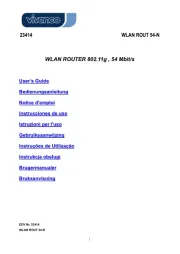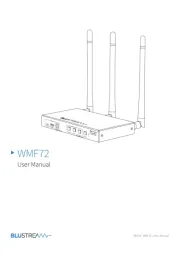Zoom 4530 Manual
Læs gratis den danske manual til Zoom 4530 (101 sider) i kategorien Router. Denne vejledning er vurderet som hjælpsom af 65 personer og har en gennemsnitlig bedømmelse på 4.5 stjerner ud af 33 anmeldelser.
Har du et spørgsmål om Zoom 4530, eller vil du spørge andre brugere om produktet?

Produkt Specifikationer
| Mærke: | Zoom |
| Kategori: | Router |
| Model: | 4530 |
| Bredde: | 187 mm |
| Dybde: | 112 mm |
| Højde: | 128 mm |
| Vægt: | - g |
| Brugervejledning: | Ja |
| Produktfarve: | Sort |
| Ethernet LAN-porte (RJ-45): | 4 |
| Ethernet LAN: | Ja |
| Wi-Fi-standarder: | 802.11b, 802.11g, Wi-Fi 4 (802.11n) |
| Ethernet LAN-datahastigheder: | 10, 100 Mbit/s |
| Sikkerhedsalgoritmer: | 128-bit WEP, 64-bit WEP, 802.1x RADIUS, WPA, WPA2, WPS |
| Hurtig start guide: | Ja |
| Frekvensområde: | 2.4 - 2.4835 GHz |
| Certificering: | FCC, CE, RoHS |
| Ethernet WAN: | Ja |
| Wi-Fi-bånd: | Ingen |
| Bedste Wi-Fi standard: | Wi-Fi 4 (802.11n) |
| WLAN dataoverførselshastighed (maks): | 150 Mbit/s |
| Ethernet LAN-grænsefladetype: | Hurtigt ethernet |
| Kabelteknologi: | 10/100Base-T(X) |
| Netværksstandarder: | IEEE 802.11b, IEEE 802.11g, IEEE 802.11n, IEEE 802.3, IEEE 802.3u |
| VPN-support: | PPTP, L2TP, IPSec |
| DC-in-stik: | Ja |
| DHCP-klient: | Ja |
| Universal Plug and Play (UPnP): | Ja |
| Understøttede netværksprotokoller: | IP |
| Antennedesign: | Intern & ekstern |
| Antenner, antal: | 2 |
| Overfører strøm: | 12 dBmW |
| Servicekvalitet support (QoS): | Ja |
| Filtrering: | Ja |
| LED-indikatorer: | Ja |
| AC-adapter inkluderet: | Ja |
| Understøttede WLAN-dataoverførselshastigheder: | 11, 54, 150 Mbit/s |
| Antal RJ-11-porte: | 1 |
| Filtrering af MAC-adresser: | Ja |
| Administrationsprotokoller: | SNMP v1/2c, SMTP, PPPoE |
| Stativ-montering: | Ingen |
| ADSL-forbindelse: | Ingen |
| Understøttelse af DMZ: | Ja |
| Datalink-protokol: | DNS |
| Intern modem: | Ja |
| Antal WLAN-forbindelser (maks.): | 253 |
Har du brug for hjælp?
Hvis du har brug for hjælp til Zoom 4530 stil et spørgsmål nedenfor, og andre brugere vil svare dig
Router Zoom Manualer






Router Manualer
- Allied Telesis
- Turtle
- Holzmann
- Comtrend
- Rocstor
- 7inova
- LevelOne
- EnVivo
- PENTAGRAM
- Western Digital
- Trust
- AVMATRIX
- Cisco
- Gembird
- AVM
Nyeste Router Manualer









